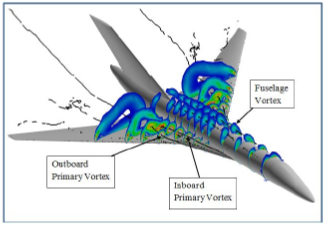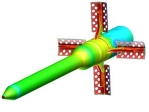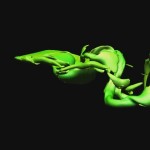Computational Fluid Dynamics(CFD) simulations are anticipated to become the primary tool in the design of modern commercial and military aircraft. Specifically, CFD has become reliable enough to detect the source of undesirable flight characteristics experienced in the flight testing. However, CFD techniques are subject to inaccuracies and must be validated and evaluated on the basis of experimental data. Researchers at the US Air Force Academy have been using Cobalt to predict static and forced motion aerodynamic responses of a canard configured TransCRuiser named the TCR. In the process, they have also examined and validated the use of Cobalt’s Overset method to simulate canard deflections.Continue reading
Category Archives: Overset
F-18C JDAM Weapon Separation
The F-18 JDAM weapon separation problem originated in 1998 as a technical challenge to the CFD community. Our original work on this and the problem definition is documented in AIAA 1999-0122 A Solution on the F-18C for Store Separation Simulation using Cobalt60. In 2007, the first version of the Cobalt Overset module was used to simulate the flow. The same job inputs were used for the V6 and V7 solutions discussed below.Continue reading
Argus Missile Fin Deployment
The Argus Missile is a ground penetrating sensor device that is dropped from an aircraft. The streamlined missile deploys 4 paddles to slow and stabilize on its descent. A computational analysis of this action is challenging due to the tight gaps between the folded paddles and missile body, the deployment action, and the motion of the sliding locking ring.Continue reading
Wing Aileron Flap
A test case of the F-15 wing, aileron and flap was used to demonstrate the application of the Cobalt v7.0 Overset Module to moving control surfaces. In this type of application, the motion is prescribed and the limits of the grid motion are known ahead of time. There is also a very tight space between the control surfaces and the wing where the code must create a good hole-cut throughout the motion cycle. This geometry also presents the overlap of three grids at the intersection of the wing, aileron, and flap. All these qualities combine to present a realistic application to be able to simulate.Continue reading





